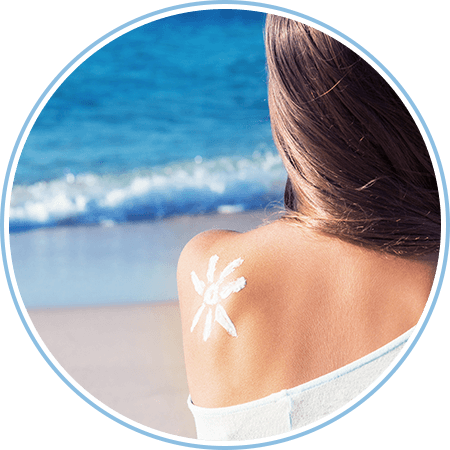Why is the sun
protection factor
important?
We use a sunscreen to protect against the harmful effects of ultraviolet (UV) rays. There are different types of UV rays, including UVB and UVA. UVB rays are mainly responsible for tanning and sunburns. UVA rays are responsible for the instant redness observed after exposure to the sun; they also contribute to premature aging of the skin. Both types of sunrays increase the risk of skin cancer.
What is the ideal SPF?
First, it is important to mention that it is never recommended to opt for an SPF lower than 15, as it is insufficient to protect against the harmful effects of sunrays. Products with an SPF between 15 and 30 provide basic protection, but not an optimal one. The Canadian Dermatology Association (CDA), recommends using a product with an SPF of at least 30 for anyone over the age of six months. This recommendation applies to all Canadians.
Choosing an SPF higher than 30 may be a wise choice for anyone wishing to maximize sun protection or for individuals who are more vulnerable to the harmful effects of sunrays, for example:
 What does the sun protection factor (SPF) represent?
What does the sun protection factor (SPF) represent?
The sun protection factor, or SPF, is a measure that allows you to estimate the degree of protection a sunscreen offers. The abbreviation SPF is always followed by a number: 15, 30, 45, 60, and so on. This number indicates the ratio between the time it takes for UV rays to produce a sunburn with sunscreen and without. Therefore, in theory, an SPF of 30 indicates that you can stay out in the sun 30 times longer without getting a sunburn.
The SPF also indicates the proportion of UVB rays that are blocked by a sunscreen. Therefore, an SPF of 15 indicates that the product can block 93% of UVB rays hitting the protected skin; an SPF of 30 indicates that it can block 96.7% of UVB rays. As you can see, the degree of sun protection is not doubled when an SPF is twice as high. The following table indicates the degree of protection that corresponds to different SPFs:
| SPF | Percentage of blocked UVB rays |
| 4 | 75 % |
| 8 | 87,5 % |
| 15 | 93 % |
| 30 | 96,7 % |
| 50 | 98 % |
| 60 | 98,3 % |
What is the ideal SPF?
First, it is important to mention that it is never recommended to opt for an SPF lower than 15, as it is insufficient to protect against the harmful effects of sunrays. Products with an SPF between 15 and 30 provide basic protection, but not an optimal one. The Canadian Dermatology Association (CDA), recommends using a product with an SPF of at least 30 for anyone over the age of six months. This recommendation applies to all Canadians.
Choosing an SPF higher than 30 may be a wise choice for anyone wishing to maximize sun protection or for individuals who are more vulnerable to the harmful effects of sunrays, for example:
Pregnant women
Hormonal changes that occur during pregnancy can cause unusual reactions to the sun, such as hyperpigmentation of the skin, which appears as brown spots or the infamous “pregnancy mask” (particularly on the stomach), and make the skin more sensitive to sunrays.Individuals with light-coloured skin or hair
Melanin, a skin pigment responsible for its coloration, provides a certain degree of sun protection. Individuals who have light-coloured hair, eyes or skin, have less melanin and consequently, are more sensitive to UV rays.Individuals who spend a lot of time outdoors
Some individuals spend more time outside due to their recreational or professional activities. Increased protection will enable them to guard against immediate effects (i.e. sunburn) and in the long-term (i.e. premature aging of the skin and skin cancer) associated with excessive exposure to the sun.Individuals who take photosensitizing medications
Some medications are photosensitizing, that is, they increase skin sensitivity during sun exposure. As a result, skin burns more quickly, and in addition, can cause redness, rash or itching during sun exposure. Speak to your pharmacist to learn if some of the medication you take has this type of effect.
A number of products offer an SPF that is higher than 50, but it has not been proven that this is really more beneficial from a sun protection perspective.
One thing is certain in all cases, whatever the SPF, a sunscreen only effectively protects against the assaults of the sun if it is generously and regularly applied.
Beyond SPF, what should be considered?
To choose a sunscreen, you must take into account the SPF and other factors as well. For additional information about it, read the following text: What should you look for in a sunscreen?

